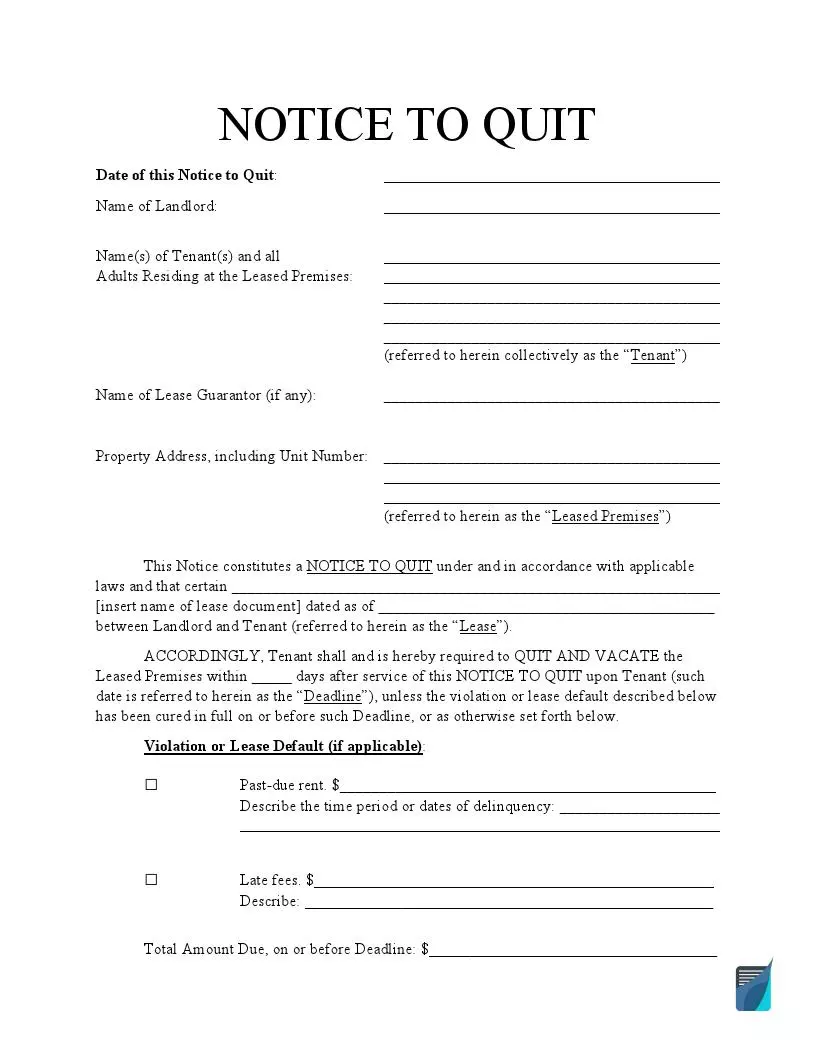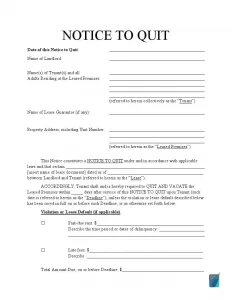10-Day Eviction Notice to Vacate
When a tenant fails to pay rent on time or breaches any terms of the lease agreement, the landlord can use a 10-day eviction notice to inform the tenant about such non-compliance. The notice gives a 10-day period for correction of the issue, upon failing which the landlord may ask the tenant to vacate the property.
The notice may be given for rental dues, violations of the agreement terms, or conduct of illegal activities at the leased property. A 10-day notice should state the following three things:
- The violation or breach made.
- The relevant terms under the agreement. For example, if rental dues have not been paid, the relevant clause stating the due date of payment should be mentioned. If unauthorized guests are staying, then the clause which prohibits the same should be referred to, and so on.
- The period given to fix the issue and the consequences of non-compliance with the notice.
Here’s the list of states where a 10-day notice to quit form is commonly used for different types of rental violations: Alaska, Arizona, Colorado, Hawaii, Illinois, Indiana, Kansas, Louisiana, Missouri, North Carolina, Pennsylvania, Washington.

Build Your Document
Answer a few simple questions to make your document in minutes
Save and Print
Save progress and finish on any device, download and print anytime
Sign and Use
Your valid, lawyer-approved document is ready
10-Day Eviction Notice to Vacate Form Details
| Document Name | 10-Day Eviction Notice to Vacate Form |
| Other Names | 10-Day Notice to Quit, Ten-Day Eviction Notice |
| Avg. Time to Fill Out | 13 minutes |
| # of Fillable Fields | 55 |
| Available Formats | Adobe PDF |

Filling Out a 10-Day Eviction Notice
FormsPal’s easy to use and understand eviction notice template can be filled out by following these simple steps:
Enter the Notice Period and Date
In the heading and the first line, enter the number “10” before the words “_ Day Notice to Quit.” Throughout the document, enter 10 before the words “_ Day Notice.”
Enter the date correctly, as the period of 10 days will be calculated starting from the day following the date mentioned. Weekends and public holidays are not included.
Enter the Name of the Parties
Enter the full name of the landlord and the tenant, as mentioned in the lease agreement. If there is a lease guarantor, mention his or her full name.
Enter the Address
Specify the full address of the leased premises, including the city, county, state, and postal code.
Enter the Agreement Details
Enter the date of the rental agreement. If you cannot recall it, check the lease agreement for the same.
Select and Describe the Reason
If the eviction notice is being sent due to illegal activities at the leased premises, select the first option. Mention the kind of illegal activities and how you came to know about them.
If the eviction notice is being sent for violations of the rental agreement, refer to the terms that the tenant has violated. For example, if unauthorized guests are staying at the premises, mention the clause from the lease agreement that prohibits the same.
If the eviction notice is being sent for non-payment of rent, specify the following information: amount due, past due date, and late fees, if applicable.
Select the Follow-up Action or Cure
Based on the reasons for sending the notice, the landlord must specify the follow-up corrective action that the tenant must take.
If the reason is the conduct of illegal activities, select the first option and mention the date by which the tenant must vacate the property.
If the reason is a violation of rental contract terms, select the second option and mention how and when the breach should be cured.
If the reason is non-payment of rent, mention the total amount due and the last date by which payment should be made.
In any case, the time given for correction cannot be less than ten days.
Enter the Notice Serving Details
In the last part, enter all the information relevant to the service of the 10-day notice. Select the mode of delivery and information (full name and address) of all the persons to whom the notice is being sent. Sign the notice and get it notarized if your state’s laws require it.
What Happens After the Notice is Delivered?
If a full rent payment is offered by the tenant, the landlord must accept it. Consequently, the eviction process cannot be done. If partial payment is offered, it can be accepted or declined at the landlord’s choice. However, if taken, a partial payment will be considered partial compliance with the notice, and eviction will not be possible.
Similarly, if the term breach is cured in entirety as demanded by the notice, the tenant cannot be asked to vacate the property. However, if partial compliance is made, it is the landlord’s choice to accept or reject it.
If no compliance is made by the tenant or if no rental dues are cleared by the tenant as demanded under the notice, an “unlawful detainer” lawsuit can be filed.